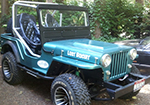 Michael writes that he’s owned several jeeps through the years. Currently, he’s got two willys trucks he’s fixed up, a ’55 and a ’57 . As you can see from the right and the first large pic below, the ’57 seems to have wings. Most recently, he’s purchased a couple slat grille jeeps and is looking for info about and parts for them.
Michael writes that he’s owned several jeeps through the years. Currently, he’s got two willys trucks he’s fixed up, a ’55 and a ’57 . As you can see from the right and the first large pic below, the ’57 seems to have wings. Most recently, he’s purchased a couple slat grille jeeps and is looking for info about and parts for them.
“Just wanted to say thanks for all the awesome info on your website! I learned to drive at the age of 10. My parents had a 1969 Jeep Gladiator Pickup. I used to fourwheel all over in it. It was given to me on my 12th birthday after I had blown up the motor wheeling in a rock canyon very similar to the Rubicon. What a time. We towed it back with a 56 Willys Wagon.
I currently own a couple Willys pickups a 55 and a 57. I’ve owned a couple 2a’s in the past and always kick myself for selling them! I am back though and looking for any info. on parts for a couple of slat Willys. That’s how I found your website. Thanks again. I’ll send you a picture of my 57′ “treading lightly?” Also pics of both are posted on car domain under the user name of UNIVERSALWILLYS1 (although it was hurriedly done so not very prof. looking.I need the time to fix them)”













